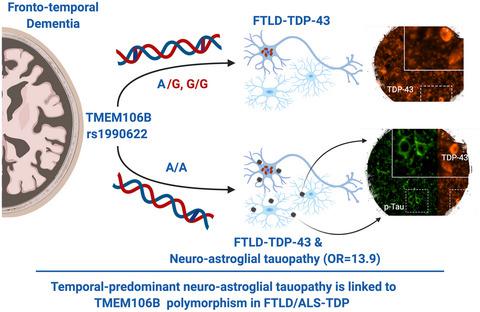当前位置:
X-MOL 学术
›
Brain Pathol.
›
论文详情
Our official English website, www.x-mol.net, welcomes your
feedback! (Note: you will need to create a separate account there.)
A novel temporal‐predominant neuro‐astroglial tauopathy associated with TMEM106B gene polymorphism in FTLD/ALS‐TDP
Brain Pathology ( IF 5.8 ) Pub Date : 2020-12-12 , DOI: 10.1111/bpa.12924 Jorge J Llibre-Guerra 1, 2, 3 , Suzee E Lee 1 , Claudia K Suemoto 4, 5 , Alexander J Ehrenberg 1, 6 , Gabor G Kovacs 7, 8, 9 , Anna Karydas 1 , Adam Staffaroni 1 , Elisa De Paula Franca Resende 1, 3, 10 , Eun-Joo Kim 11 , Ji-Hye Hwang 1 , Eliana Marisa Ramos 12 , Kevin J Wojta 12 , Lorenzo Pasquini 1 , Shirley Yin-Yu Pang 13 , Salvatore Spina 1 , Isabel E Allen 3, 14 , Joel Kramer 1 , Bruce L Miller 1 , William W Seeley 1, 15 , Lea T Grinberg 1, 3, 4, 15
Brain Pathology ( IF 5.8 ) Pub Date : 2020-12-12 , DOI: 10.1111/bpa.12924 Jorge J Llibre-Guerra 1, 2, 3 , Suzee E Lee 1 , Claudia K Suemoto 4, 5 , Alexander J Ehrenberg 1, 6 , Gabor G Kovacs 7, 8, 9 , Anna Karydas 1 , Adam Staffaroni 1 , Elisa De Paula Franca Resende 1, 3, 10 , Eun-Joo Kim 11 , Ji-Hye Hwang 1 , Eliana Marisa Ramos 12 , Kevin J Wojta 12 , Lorenzo Pasquini 1 , Shirley Yin-Yu Pang 13 , Salvatore Spina 1 , Isabel E Allen 3, 14 , Joel Kramer 1 , Bruce L Miller 1 , William W Seeley 1, 15 , Lea T Grinberg 1, 3, 4, 15
Affiliation

|
Polymorphisms in TMEM106B, a gene on chromosome 7p21.3 involved in lysosomal trafficking, correlates to worse neuropathological, and clinical outcomes in frontotemporal lobar degeneration (FTLD) and amyotrophic lateral sclerosis (ALS) with TDP‐43 inclusions. In a small cohort of C9orf72 expansion carriers, we previously found an atypical, neuroglial tauopathy in cases harboring a TMEM106B rs1990622 A/A genotype. To test whether TMEM106B genotype affects the risk of developing atypical tauopathy under a recessive genotype model (presence versus absence of two major alleles: A/A vs. A/G and G/G). We characterized the atypical tauopathy neuropathologically and determined its frequency by TMEM106B rs1990622 genotypes in 90 postmortem cases with a primary diagnosis of FTLD/ALS‐TDP [mean age at death 65.5 years (±8.1), 40% female]. We investigated the effect of this new atypical tauopathy on demographics and clinical and neuropsychological metrics. We also genotyped TMEM106B in an independent series with phenotypically similar cases. Sixteen cases (16/90, 17.7 %) showed the temporal‐predominant neuro‐astroglial tauopathy, and 93.7% of them carried an A/A genotype (vs. ~35% in a population cohort). The odds ratio of FTLD/ALS‐TDP individuals with the A/A genotype showing neuro‐astroglial tauopathy was 13.9. Individuals with this tauopathy were older at onset (p = 0.01). The validation cohort had a similarly high proportion of rs1990622 A/A genotype. TDP‐43 and tau changes co‐occur in a subset of neurons. Our data add to the growing body of evidence that TMEM106B polymorphisms may modulate neurodegeneration. A distinctive medial temporal predominant, 4‐repeat, neuro‐astroglial tauopathy strongly correlates to TMEM106B A/A genotype in FTLD/ALS‐TDP cases.
中文翻译:

一种与 FTLD/ALS-TDP 中 TMEM106B 基因多态性相关的新型时间主导型神经星形胶质细胞 tau 病变
TMEM106B中的多态性是染色体 7p21.3 上参与溶酶体运输的基因,与额颞叶变性 (FTLD) 和具有 TDP-43 包涵体的肌萎缩侧索硬化 (ALS) 中较差的神经病理学和临床结果相关。在一小群C9orf72扩增携带者中,我们之前在携带TMEM106B rs1990622 A/A 基因型的病例中发现了一种非典型的神经胶质 tau 病变。测试TMEM106B基因型是否影响在隐性基因型模型下发生非典型 tau 病的风险(存在与不存在两个主要等位基因:A/A 与 A/G 和 G/G)。我们在神经病理学上表征了非典型 tau 病并通过TMEM106B确定了它的频率90 例初步诊断为 FTLD/ALS-TDP 的 rs1990622 基因型[平均死亡年龄 65.5 岁 (±8.1),40% 为女性]。我们研究了这种新的非典型 tau 蛋白病对人口统计学、临床和神经心理学指标的影响。我们还在具有表型相似病例的独立系列中对TMEM106B进行了基因分型。16 例 (16/90, 17.7 %) 表现出颞叶为主的神经星形胶质细胞 tau 病变,其中 93.7% 携带 A/A 基因型(与人群队列中的约 35% 相比)。具有显示神经星形胶质细胞 tau 病的 A/A 基因型的 FTLD/ALS-TDP 个体的比值比为 13.9。患有这种 tau 病的个体发病时年龄较大(p = 0.01)。验证队列具有类似高比例的 rs1990622 A/A 基因型。TDP-43 和 tau 变化在神经元子集中同时发生。我们的数据增加了越来越多的证据表明TMEM106B多态性可能调节神经变性。在 FTLD/ALS-TDP 病例中,一种独特的内侧颞叶主导的、4 次重复的神经星形胶质细胞 tau 病与TMEM106B A/A 基因型密切相关。
更新日期:2020-12-12
中文翻译:

一种与 FTLD/ALS-TDP 中 TMEM106B 基因多态性相关的新型时间主导型神经星形胶质细胞 tau 病变
TMEM106B中的多态性是染色体 7p21.3 上参与溶酶体运输的基因,与额颞叶变性 (FTLD) 和具有 TDP-43 包涵体的肌萎缩侧索硬化 (ALS) 中较差的神经病理学和临床结果相关。在一小群C9orf72扩增携带者中,我们之前在携带TMEM106B rs1990622 A/A 基因型的病例中发现了一种非典型的神经胶质 tau 病变。测试TMEM106B基因型是否影响在隐性基因型模型下发生非典型 tau 病的风险(存在与不存在两个主要等位基因:A/A 与 A/G 和 G/G)。我们在神经病理学上表征了非典型 tau 病并通过TMEM106B确定了它的频率90 例初步诊断为 FTLD/ALS-TDP 的 rs1990622 基因型[平均死亡年龄 65.5 岁 (±8.1),40% 为女性]。我们研究了这种新的非典型 tau 蛋白病对人口统计学、临床和神经心理学指标的影响。我们还在具有表型相似病例的独立系列中对TMEM106B进行了基因分型。16 例 (16/90, 17.7 %) 表现出颞叶为主的神经星形胶质细胞 tau 病变,其中 93.7% 携带 A/A 基因型(与人群队列中的约 35% 相比)。具有显示神经星形胶质细胞 tau 病的 A/A 基因型的 FTLD/ALS-TDP 个体的比值比为 13.9。患有这种 tau 病的个体发病时年龄较大(p = 0.01)。验证队列具有类似高比例的 rs1990622 A/A 基因型。TDP-43 和 tau 变化在神经元子集中同时发生。我们的数据增加了越来越多的证据表明TMEM106B多态性可能调节神经变性。在 FTLD/ALS-TDP 病例中,一种独特的内侧颞叶主导的、4 次重复的神经星形胶质细胞 tau 病与TMEM106B A/A 基因型密切相关。











































 京公网安备 11010802027423号
京公网安备 11010802027423号